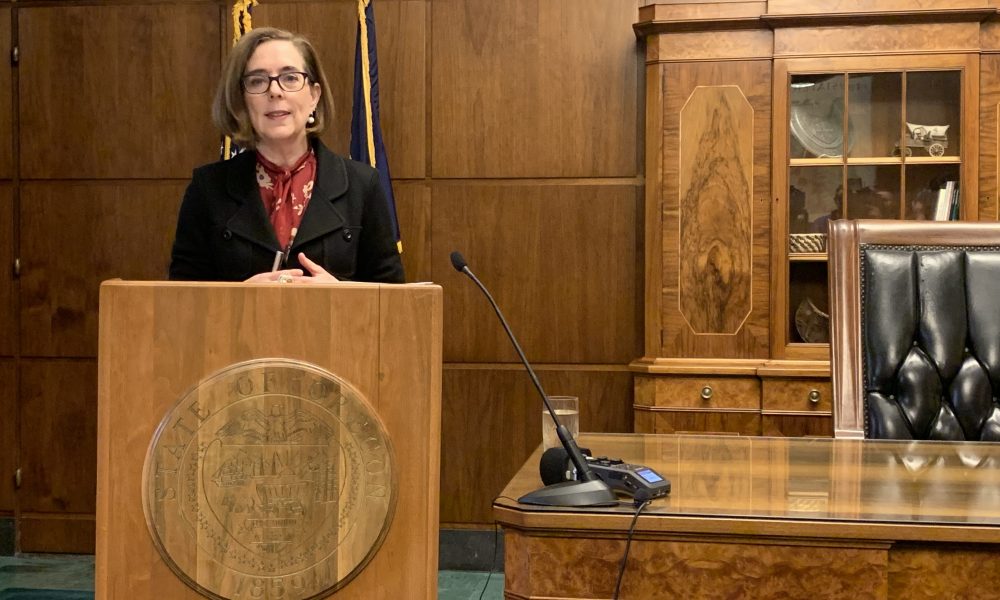
Gov. Kate Brown announces her proposed two-year state budget during a news conference Wednesday in the governor’s office in Salem. (Salem Reporter/Aubrey Wieber)
SALEM — Revealing ambitions for her final term, Gov. Kate Brown on Wednesday announced a record expansion of school funding, a revamping of the state approach to energy issues and readying for legal battle against the Trump administration.
Under her proposed two-year budget, school kids would have smaller classes and more teachers, more Oregonians could find housing, and the state’s highway would be patrolled by more troopers.
Overall, she is proposing a total two-year state budget of $83.5 billion, including $22.3 billion in general fund spending. Currently, the state is working off a $74 billion budget that includes $19.8 billion in general fund money, which primarily comes from tax collections.
Brown unveiled her spending blueprint at a news conference at the Capitol. Her ideas now face the legislative gauntlet and certain modification before the new budget cycle starts next July 1.
Days before Brown won re-election, she told Salem Reporter her legacy would be Future Ready Oregon, her comprehensive policy designed to steer the state’s economy for generations while withstanding economic downturns.
The building blocks for that can be found throughout her proposed budget, from the $2 billion increase in education funding to the construction of up to 2,100 affordable homes to increases in child welfare services.
“She’s been around long enough to know this is her four years of opportunity,” said Katy Coba, director of the Department of Administrative Services. “This budget does lay that ground work.”
Coba has been in state politics for more than two decades, and led the state Department of Agriculture before Brown appointed her to run DAS in 2016. She said with a strong economy and a Legislature favorable to Brown’s policies, the “stars aligned.”
“It is truly a historic opportunity for a governor to put together an aggressive budget, and that is exactly what this governor has done,” Coba said.

Brown clearly was focused on schools.
Since the 1990s, Oregon’s funding per student has declined. According to the proposed budget, it is now underfunded by $1 billion per year, according to a state education commission. To counter that, Brown is proposing spending $800 million of her new education dollars on bolstering the K-12 system, expanding the school year to 180 days school year and limiting class sizes for kindergarten through third grade.
The proposed budget opens up 10,000 new state-funded preschool slots and dedicates $4 million for state visits to homes with young children.
The governor has also made career technical training a larger part of public education, proposing an additional $133 million goes to CTE programs in public schools and $70 million goes to colleges.
Brown wants to allocate $406 million to the state’s housing crisis, spending on new affordable units, housing assistance programs, providing gap financing for new construction, and funding efforts to eradicate child and veteran homelessness in Oregon.
Brown also unveiled her blueprint for Oregon to implement cap, trade and invest policy for carbon emissions. It would set gradually tighter limits for emissions and allow companies to sell any excess emissions capacity in the form of credits. Those credits could then be sold to other companies who exceed the limits. Similar legislation has been cycling through the Legislature in recent years.
Less expected, however, is Brown’s proposal to dismantle the Oregon Department of Energy and Carbon Policy Office and create the Oregon Climate Authority. The new agency would oversee the emissions credit marketplace as well as compliance with the carbon cap. It’s unclear what would happen to other duties in the beleaguered Energy Department.
The policies are flashy and expensive, but they are also what Brown campaigned on. Issues such as education spending and a carbon cap have been examined in recent months by legislative committees.
“We’re tackling some big things: education, health care, climate,” Coba said. “Those are all big, big items. And yet, there seems to be a lot of political alignment, so it’s not coming out of left field. These things are T’d up.”
In addition to the more eye-catching pillars of the budget, Brown is proposing other impactful policies throughout. The Oregon State Police is funded by the general fund, where there is always high competition for dollars. As a result, trooper numbers have not kept pace with population increases, and there are now eight troopers for every 100,000 Oregonians.
Brown plans to double the number of troopers in the next decade, and is starting by allocating $8 million to fill current vacancies and $3 million to fund 10 new positions. She also said she will seek modest gun control legislation and follow up on the campaign promise of spending in rural Oregon.
The governor shared other proposals to change the state that don’t cost tens or hundreds of millions of dollars. She wants to push for campaign finance reform, establish a commission to look into “dark money” and a real-time reporting of spending and contributions for political campaigns.
She also wants to expand her motor voter policy so Oregonians buying fishing licenses, taking public college classes or signing up for health care through the state exchange automatically will be registered to vote, as they are now when registering with the DMV. Additionally, Brown is proposing that mailed ballots come with return envelopes carrying prepaid postage.
The budget plan also includes $875 million from new and renewed taxes and penalties, including a $2 per-pack cigarette tax. She also plans to hire 13 internal state agency auditors to look for ways to be more efficient.
Reporter Aubrey Wieber: [email protected] or 503-575-1251. Reporter Claire Withycombe: [email protected] or 503-385-4903. Wieber is a reporter for Salem Reporter and Withycombe is a reporter for the East Oregonian. They work for the Oregon Capital Bureau, a collaboration of EO Media Group, the Pamplin Media Group, and Salem Reporter.









